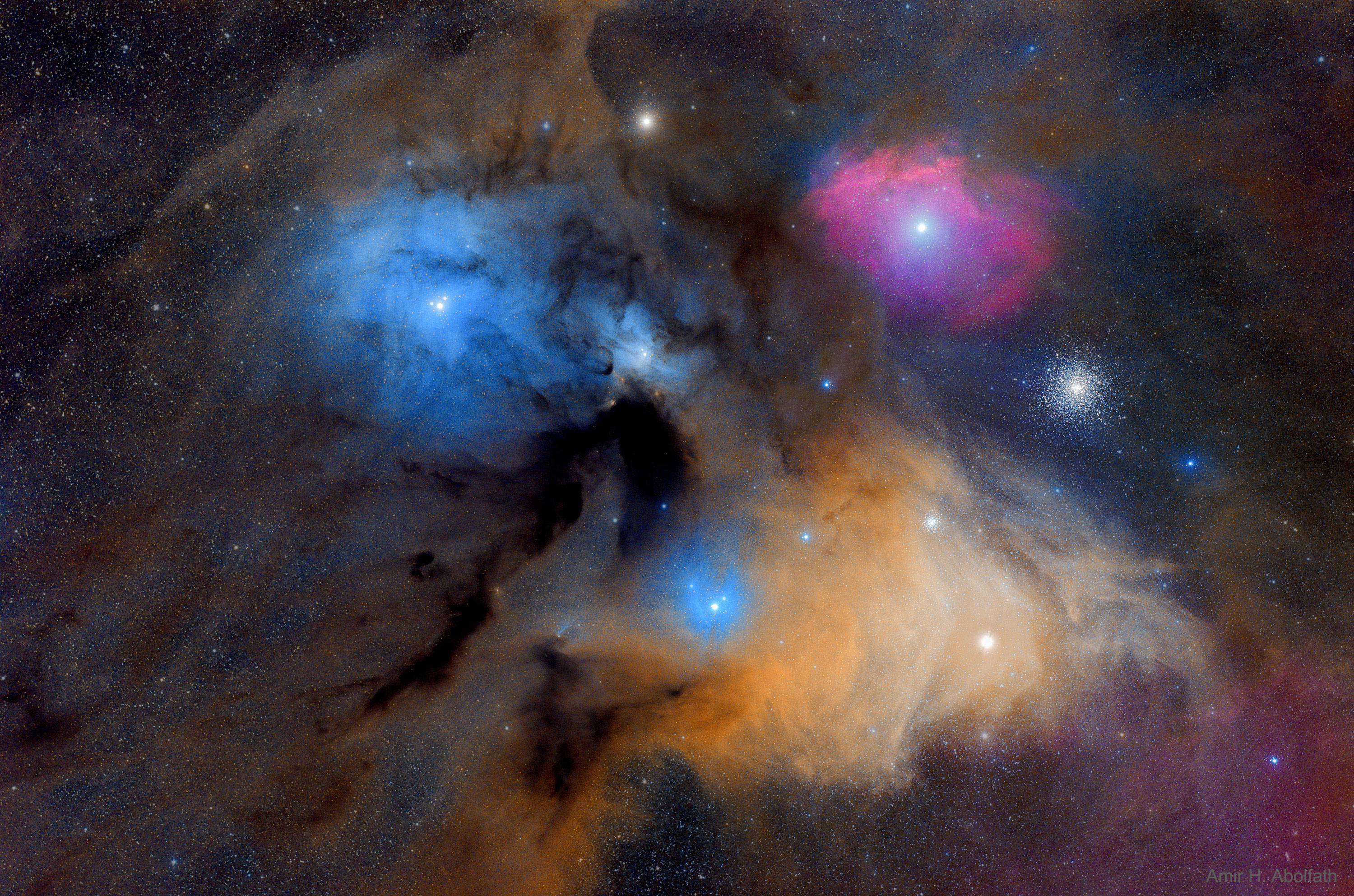
Posted on 10/14/2020 5:44:16 PM PDT by MtnClimber
Explanation: The many spectacular colors of the Rho Ophiuchi (oh'-fee-yu-kee) clouds highlight the many processes that occur there. The blue regions shine primarily by reflected light. Blue light from the Rho Ophiuchi star system and nearby stars reflects more efficiently off this portion of the nebula than red light. The Earth's daytime sky appears blue for the same reason. The red and yellow regions shine primarily because of emission from the nebula's atomic and molecular gas. Light from nearby blue stars - more energetic than the bright star Antares - knocks electrons away from the gas, which then shines when the electrons recombine with the gas. The dark brown regions are caused by dust grains - born in young stellar atmospheres - which effectively block light emitted behind them. The Rho Ophiuchi star clouds, well in front of the globular cluster M4 visible here on the upper right, are even more colorful than humans can see - the clouds emits light in every wavelength band from the radio to the gamma-ray.
(Excerpt) Read more at apod.nasa.gov ...
For more detail go to the link and click on the image for a high definition image. You can then zoom by moving the magnifying glass over an area and then clicking. The side bars will move the zoomed area over the photograph.

Pinging the APOD list.
I must be pretty weird. I’m fascinated by stars and planets, and I love the APOD dailies, but I’m bored by nebula’s. I find gas clouds to be one of the most uninteresting things about space. Big deal, colored gasses.
That, and this one is so gay...
Plus, the colors are so cloying.
Looks like a never ending source of printer ink.
Like my EcoTank?
I really wonder what the radiation environment in that star cluster is like. I would suspect nothing can live with all those stars blasting away.
It is probably a bad environment. They could get in trouble with the EPA and OSHA too.
Looks like Jar Jar Binks to me.
Why that man has never won an academy award is beyond me.
Jar Jar Binks getting ready to eat a blue cheeseburger.
Of course!
Why didn’t I see that?
It’s as plain as can be!
A blue cheeseburger.
Ummmm.....does it have a bun? Just asking for a friend.
I mean, I can easily see it.
(It should actually be in the zodiac)
"Ophiuchus lies between Aquila, Serpens, Scorpius, Sagittarius, and Hercules, northwest of the center of the Milky Way. The southern part lies between Scorpius to the west and Sagittarius to the east.[1][2][3] In the northern hemisphere, it is best visible in summer.[4] It is opposite Orion. Ophiuchus is depicted as a man grasping a serpent; the interposition of his body divides the snake constellation Serpens into two parts, Serpens Caput and Serpens Cauda. Ophiuchus straddles the equator with the majority of its area lying in the southern hemisphere. Rasalhague, its brightest star, lies near the northern edge of Ophiuchus at about +12° 30′ declination.[5] The constellation extends southward to −30° declination. Segments of the ecliptic within Ophiuchus are south of −20° declination.
In contrast to Orion, from November to January (summer in the Southern Hemisphere, winter in the Northern Hemisphere), Ophiuchus is in the daytime sky and thus not visible at most latitudes. However, for much of the Arctic Circle in the Northern Hemisphere's winter months, the Sun is below the horizon even at midday. Stars (and thus parts of Ophiuchus, especially Rasalhague) are then visible at twilight for a few hours around local noon, low in the south. In the Northern Hemisphere's spring and summer months, when Ophiuchus is normally visible in the night sky, the constellation is actually not visible, because the midnight sun obscures the stars at those times and places in the Arctic. In countries close to the equator, Ophiuchus appears overhead in June around midnight and in the October evening sky."


Disclaimer: Opinions posted on Free Republic are those of the individual posters and do not necessarily represent the opinion of Free Republic or its management. All materials posted herein are protected by copyright law and the exemption for fair use of copyrighted works.